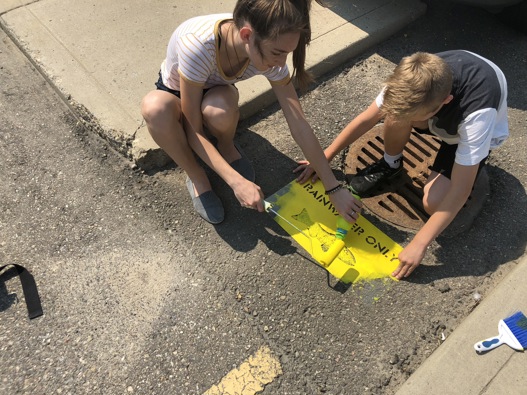The water we use in our houses and businesses goes to the Wastewater Treatment Plant. This water is cleaned and discharged back to the Oldman River. Find out more about the Wastewater Treatment Plant in Lethbridge.
Stormwater and Wastewater
Find the answers to your questions or obtain more information about your water or wastewater service, the quality of water, or the treatment processes.
Where does our water go after we use it in our buildings?
Where does our water go after we use it outside?
The water that enters stormdrains in your neighbourdood is called stormwater. Any water that enters the storm drains flows directly from Lethbridge streets into the Oldman River or into storage retention facilities called storm ponds. There is no direct treatment of stormwater. Storm ponds help filter water before they reach the Oldman River.
The City of Lethbridge operates more than 30 Storm Ponds located throughout the City. These storm water reservoirs' primary function is to collect and store excess storm water to prevent flooding. Storm ponds are designed with inlets for storm water to enter during high rainfall events and outlets to slowly release excess water afterwards. Some ponds have irrigation make up water to keep them filled, because water from the pond is used to irrigate the park during the summer months. These “lakes” found in your neighbourhood are not constructed to be a public recreational facility.
You can be of service to our storm ponds by ensuring you do not release goldfish or other aquarium species into our storm ponds.
Common stormwater and wastewater topics
Check out some of the frequently asked questions and topics on stormwater and wastewater below.
Find out the current wastewater rates.
Do you have sewer issues?
Give us a call at 311 if you have any questions or if you are experiencing water/sewer problems.
We will send someone out to investigate if we can't help you over the phone. In emergency situations, we have coverage 24/7.
Find out more about sewer problems.
To ensure you avoid unnecessary sewer problems in the future, ensure you are not flushing wipes, fats, oils, grease, hair, and many other items down the drains in your house or business!
How can I get a sewer line replacement?
- Call the City of Lethbridge to obtain a video inspection to determine if replacement is necessary. A clean out must be accessible for this to occur.
Please see the sewer problems page for more information. - Call Contractor(s) for sewer relining/replacement on the property owner's side and obtain quote(s). It is recommended that you obtain at least 2 quotes from different contractors
- Replacement occurs after verification of repairs to be done. The City will be responsible for the replacement and cost from the property line to the street. The Contractor hired by the homeowner will be responsible for the replacement from the home to the property line, with the cost to the homeowner. By doing these at the same time, it offers cost-saving to the homeowner.
Note: Property lines vary from location to location.
Call 311 if you have any further questions.
Sump pumps remove water that is collected from a building’s foundation and are commonly found in basements in Lethbridge. A sump pump can sometimes create issues adjacent to the property. The property owner is responsible to address any issue identified by the City of Lethbridge.
Homes built in new neighbourhoods, since 2005, are connected underground to the stormwater system. This arrangement eliminates issues with adjacent properties.
What Bylaws cover sump pump discharge?
- Bylaw #5594, Drainage Bylaw - Section 13.7
- Bylaw #3250, Sewerage Service - Section 13.08
Resources:
Leaks inside your home can be costly and waste thousands of litres of water each year. A bursting pipe in your home calls for immediate action but what about those slow leaks that go undetected for years?
Household leaks can account for over 6000 litres of wasted water every month per household. The following are typically the largest water leakers in the home:
- Toilets can waste over 4000 litres per month, or 60%
- Small drips: 16%
- Faucets: 15%
- Showers: 3%
Fixing household water leaks can save 10% on your water utility bill!
Take action and find and fix leaks in your house. Call a plumber if you need assistance.
Backflow preventer valves (cross connection controls)
It is necessary to fill out the following form to ensure compliance with Bylaw 3999.
Looking for community volunteer opportunities?
Our stormwater programs are a great way to get involved in the community, and help the environment too!

Adopt A Stormdrain in your neighbourhood and keep our Oldman River and neighbourhoods free of debris, healthy and clean. Adopt a stormdrain online!
Yellow Fish Road Program is a free storm drain painting program that promotes awareness about urban runoff pollution with various groups such as school classes, eco clubs, youth groups, neighborhood groups, or even your family/friends! Check out the brochure and sign up today! You can watch this Yellow Fish Road Introduction to learn more about the program.
Gutter Buddy Program encourages residents to keep their stormdrains and gutters free of debris. Watch the Become a Gutter Buddy video to learn what you need to do to help.
Xeriscaping is the practice of converting conventional turf yards into beautiful, practical and environmentally sustainable areas. By following some of the seven principles of xeriscaping, yards and gardens can use less water, and use no fertilizer or pesticides. Less on our yards, means less in our water!
Contact Us
City Hall
910 4 Avenue South
Lethbridge, AB T1J 0P6
Phone: 311
or 403-320-3111 (if outside of Lethbridge)
